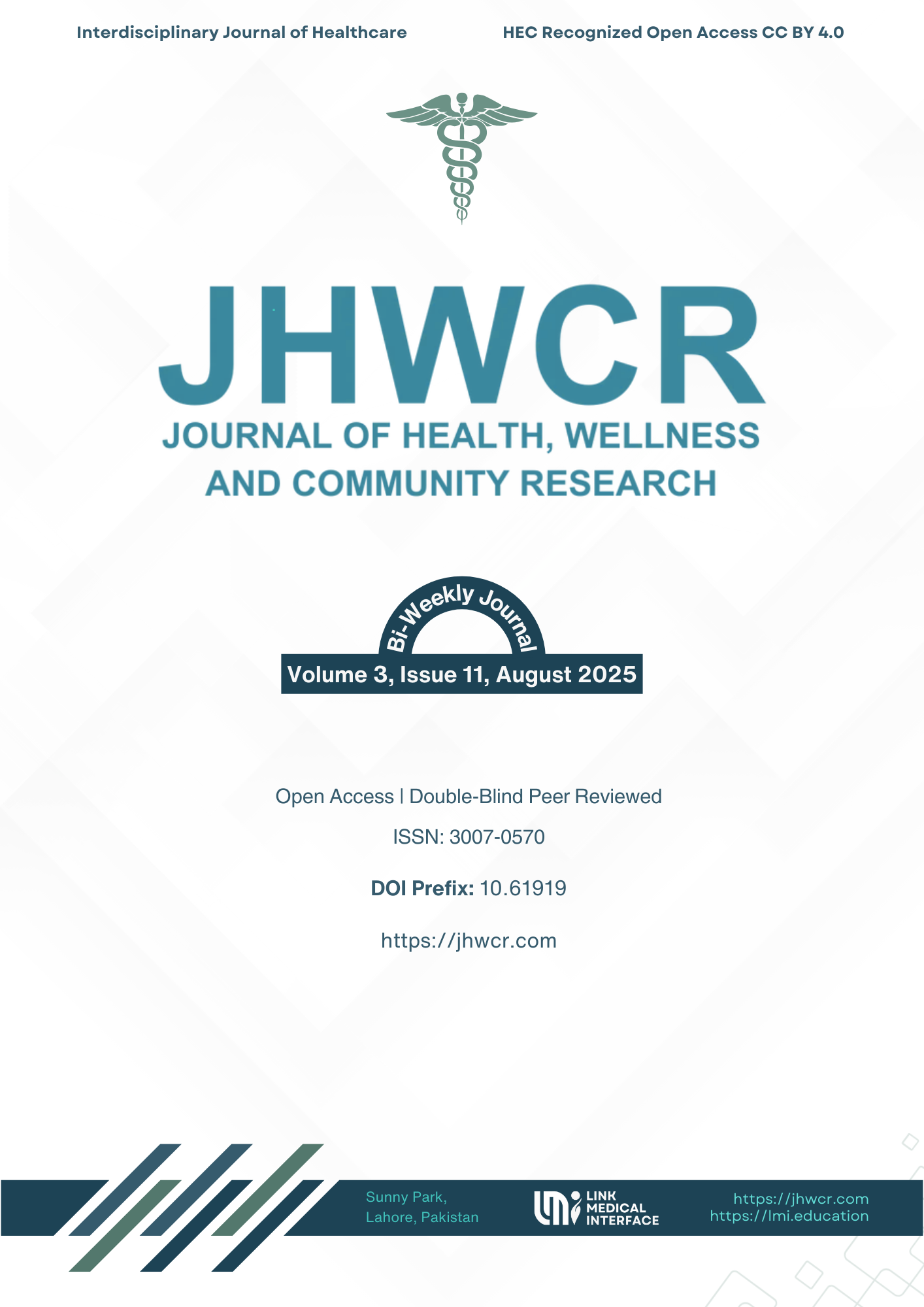An Observational Study on Upper Cross Syndrome in Undergraduate Medical Students of Allama Iqbal Medical College
DOI:
https://doi.org/10.61919/p1dpme44Keywords:
Upper Cross Syndrome, Neck Disability Index, Medical students, Posture, Musculoskeletal disorders.Abstract
Background: Upper Cross Syndrome (UCS) is a musculoskeletal condition characterized by postural imbalance and functional disability, commonly associated with sedentary behaviour and prolonged study hours. Medical students are at heightened risk due to sustained forward head posture, extended screen use, and academic stress, yet evidence from South Asian populations remains limited. Objective: To determine the prevalence and severity of UCS among undergraduate medical students at Allama Iqbal Medical College, Lahore, and to assess demographic associations with disability levels. Methods: A cross-sectional observational study was conducted among 76 medical students aged 18–30 years. Participants with musculoskeletal pain lasting at least one month were included, while those with congenital deformities, fractures, surgery, or systemic illness were excluded. The Neck Disability Index (NDI), Pectoralis Major Contracture Test, and Trapezius Strength Test were administered. Reliability analysis confirmed strong internal consistency (Cronbach’s α = 0.813). Data were analysed using chi-square tests and logistic regression, with significance set at p < 0.05. Results: Moderate disability was the most prevalent finding, reported in 66.2% of participants. Severe disability was noted in 16.9%, while 5.2% were classified as crippled. Gender and age group differences were not statistically significant (p = 0.14 and p = 0.54, respectively). Conclusion: UCS is highly prevalent among medical students, with two-thirds experiencing moderate disability. Preventive ergonomic interventions, posture correction, and stress management strategies are recommended to mitigate long-term musculoskeletal morbidity.
References
1. Morris CE, Bonnefin D, Darville C. The Torsional Upper Crossed Syndrome: A multi-planar update to Janda's model, with a case series introduction of the mid-pectoral fascial lesion as an associated etiological factor. Journal of bodywork and movement therapies. 2015;19(4):681-9.
2. Mujawar JC, Sagar JH. Prevalence of upper cross syndrome in laundry workers. Indian Journal of Occupational and Environmental Medicine. 2019;23(1):54.
3. Dhage P, Anap D. Prevalence of an “Upper Crossed Syndrome in Physiotherapy College Students”–A Cross-Sectional Study. VIMS Health Science Journal. 2019;6(1):10-3.
4. Shahid S, Tanveer F, Dustgir A. Prevalence and risk factors for the development of upper-crossed syndrome (UCS) among DPT students of university of Lahore. Age. 2016;19:0-98.
5. Al-Mohrej OA, AlShaalan NS, Al-Bani WM, Masuadi EM, Almodaimegh HS. Prevalence of musculoskeletal pain of the neck, upper extremities and lower back among dental practitioners working in Riyadh, Saudi Arabia: a cross-sectional study. BMJ open. 2016;6(6):e011100.
6. Rafie F, Zamani Jam A, Shahravan A, Raoof M, Eskandarizadeh A. Prevalence of upper extremity musculoskeletal disorders in dentists: symptoms and risk factors. Journal of environmental and public health. 2015;2015(1):517346.
7. Van der Molen HF, Foresti C, Daams JG, Frings-Dresen MH, Kuijer PPF. Work-related risk factors for specific shoulder disorders: a systematic review and meta-analysis. Occupational and environmental medicine. 2017;74(10):745-55.
8. Latko WA, Armstrong TJ, Franzblau A, Ulin SS, Werner RA, Albers JW. Cross‐sectional study of the relationship between repetitive work and the prevalence of upper limb musculoskeletal disorders. American journal of industrial medicine. 1999;36(2):248-59.
9. Tajika T, Yamamoto A, Oya N, Okura C, Shinagawa S, Kitagawa T, et al. Association between dysfunction of upper extremity and locomotive syndrome in general population. Journal of Orthopaedic Science. 2017;22(1):144-8.
10. Mubeen I, Malik S, Akhtar W, Iqbal M, Asif M, Arshad A, et al. Prevalence of upper cross syndrome among the medical students of University of Lahore. International journal of Physiotherapy. 2016;3(3):381-4.
11. Daneshmandi H, Harati J, Fahim Poor S. Bodybuilding links to upper crossed syndrome. Physical Activity Review. 2017(5):124-31.
12. Mujawar JC, Sagar JH. Prevalence of Upper Cross Syndrome in Laundry Workers. Indian J Occup Environ Med. 2019;23(1):54-6.
13. Chandarana P, Rathod S, Sorani D. Prevalence of upper crossed syndrome in college going students–an observational study. International Journal of Health Sciences and Research. 2022;12(3):179-86.
14. Naseer R, Tauqeer S. Prevalence of upper cross syndrome in different occupations. Pakistan Journal of Physical Therapy (PJPT). 2021:03-7.
15. Karimian R, Rahnama N, Ghasemi G, Lenjannejadian S. Association between upper-extremity musculoskeletal disorders and upper cross syndrome among teachers, and the effects of NASM corrective exercises along with ergonomic intervention on their upper-extremity musculoskeletal disorders. Studies in Medical Sciences. 2021;31(4):10-5.
16. Mubashir M. A cross-sectional survey on prevalence of upper cross syndrome and its correlation to WRMSDS in working physiotherapists. Pakistan Journal of Rehabilitation. 2021;10(1):42-50.
17. Fatima A, Ashraf HS, Sohail M, Akram S, Khan M, Azam H. Prevalence of upper cross syndrome and associated postural deviations in computer operators; a qualitative study. Asian Journal of Allied Health Sciences (AJAHS). 2022;7(3).
18. Hussain G, Nawaz A, Haroon M, Amon SK, Khan H. Prevalence of upper cross syndrome in working female physiotherapists: a cross-sectional survey. Biol Clin Sci Res J. 2023;402.
19. Rugbeer N, Neveling N, Sandla T. The prevalence of work-related musculoskeletal disorders in long-distance bus drivers. South African Journal of Sports Medicine. 2016;28(2):55-8.
20. Parno A, Sayehmiri K, Parno M, Khandan M, Poursadeghiyan M, Maghsoudipour M, et al. The prevalence of occupational musculoskeletal disorders in Iran: A meta-analysis study. Work. 2017;58(2):203-14.
Downloads
Published
Data Availability Statement
data will be available as per requirements keeping its privacy intact.
Issue
Section
License
Copyright (c) 2025 Sharjeel Bin Munir, Sidra Kaynat, Faiza Munir, Eisha Shahzad, Mahrukh Hayat, Syed Usman Ahmad Gillani, Faiz-ur-Rehman, Kainat Fatima (Author)

This work is licensed under a Creative Commons Attribution 4.0 International License.


